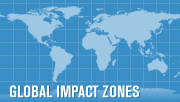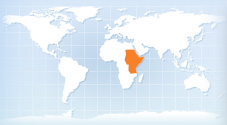Global warming exacerbates African conflict

Africa is arguably the most vulnerable continent to the impacts of global warming, despite being the least responsible for the pollution causing it. By the year 2080, East Africa’s temperature is predicted to rise 5.4 to 7.2 degrees Fahrenheit, one and a half times more than the projected average for the rest of the world. Droughts, flooding, famine, species extinction, and conflicts are all made worse by global warming in East Africa.
Global warming making tough conditions even tougher
In recent years, droughts, floods, and subsequent famine and disease have devastated East Africa and affected countless millions of people. The region's poverty limits the ability of the people to recover and adapt to these conditions. In 2006, Kenya's government declared a state of emergency after two and a half years of drought. Lack of rain has resulted in a decline in harvests, and it is estimated that nearly 2.5 million Kenyans are close to starvation.
Other East African countries are dealing with these conditions in 2006 as well: around 1.5 million people are near starvation in Ethiopia, 1.4 million in Somalia, and about 60,000 in Djibouti. With much of rural East Africa already struggling to obtain adequate fresh water supplies, the drier conditions and altered precipitation patterns as a result of global warming will make meeting the water needs of some of the poorest Africans that much harder.
When rains finally do return, they can pose their own threats. In 2006, floods in East Africa displaced over 1.8 million and killed over 1,000 citizens, many of which were the result of water borne diseases like cholera. Global warming will make overcoming the existing health challenges of cholera, malaria and malnutrition much harder for East African countries, and by 2030 the region is predicted to suffer some of the highest death rates from climate change in the world.
Increased strife from a changing climate
Global warming will also play a crucial role in the political stability of the region. Conflicts in Somalia and Sudan have been linked to global warming. The events in the Darfur region of Sudan spurred the first-ever debate on climate change and armed conflict at the U.N. Security Council. In his testimony before the Select Committee, General Gordon Sullivan, former Army Chief of Staff, described global warming as a "threat multiplier" in volatile parts of the world due to its ability to intensify already existing problems.
Shortages of water and changing precipitation patterns lead to disputes over water supplies and remaining viable farmland that can end in war and human rights abuses.
Facing serious impacts from global warming, many citizens of eastern Africa are taking on environmental issues. Waagari Maathai of Kenya was awarded the Nobel Peace Prize for her environmental efforts both in the world and in Kenya. In 1977, Maathai founded the Green Belt Movement, which focused its efforts on growing trees to both conserve the environment and improve quality of life. Maathai has led the effort to plant over 30 million trees in Kenya to help the environment. By East African’s following the lead of those like Maathai, East Africa can stand as a leader in environmental change. Something as simple as growing one tree can help provide vital environmental improvements to this region.



